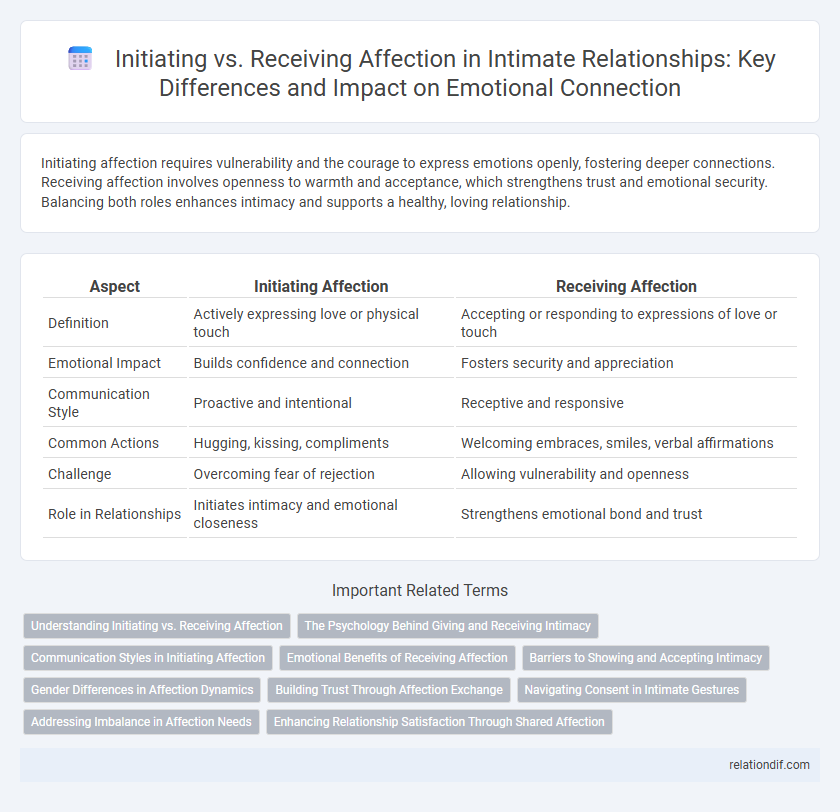Initiating affection requires vulnerability and the courage to express emotions openly, fostering deeper connections. Receiving affection involves openness to warmth and acceptance, which strengthens trust and emotional security. Balancing both roles enhances intimacy and supports a healthy, loving relationship.
Table of Comparison
| Aspect | Initiating Affection | Receiving Affection |
|---|---|---|
| Definition | Actively expressing love or physical touch | Accepting or responding to expressions of love or touch |
| Emotional Impact | Builds confidence and connection | Fosters security and appreciation |
| Communication Style | Proactive and intentional | Receptive and responsive |
| Common Actions | Hugging, kissing, compliments | Welcoming embraces, smiles, verbal affirmations |
| Challenge | Overcoming fear of rejection | Allowing vulnerability and openness |
| Role in Relationships | Initiates intimacy and emotional closeness | Strengthens emotional bond and trust |
Understanding Initiating vs. Receiving Affection
Understanding initiating versus receiving affection involves recognizing the differences in emotional expression and vulnerability between the two roles. Initiating affection requires confidence and attentiveness to a partner's cues, while receiving affection emphasizes openness and responsiveness to emotional connection. Both dynamics contribute to building trust and deepening intimacy within relationships.
The Psychology Behind Giving and Receiving Intimacy
Initiating affection often stems from a desire to express vulnerability and foster emotional connection, triggering positive neural responses linked to trust and bonding in the brain's limbic system. Receiving affection activates oxytocin release, enhancing feelings of security and reducing stress through the regulation of cortisol levels. The psychology behind giving and receiving intimacy revolves around reciprocal emotional exchange, balancing individual attachment needs and promoting overall relationship satisfaction.
Communication Styles in Initiating Affection
Initiating affection often involves more proactive and expressive communication styles, such as verbal affirmations, physical touch, or thoughtful gestures that convey desire and care. Individuals who initiate affection tend to use clear, direct signals to express their emotions, which can enhance emotional closeness and reduce misunderstandings. Effective communication when initiating affection also requires sensitivity to the partner's response style, fostering a balanced exchange that strengthens intimacy.
Emotional Benefits of Receiving Affection
Receiving affection nurtures emotional well-being by fostering feelings of security and acceptance, which strengthen trust in relationships. Physical touch and kind words stimulate oxytocin production, reducing stress and promoting happiness. This emotional nourishment enhances self-esteem and deepens the bond between partners, creating a resilient and supportive connection.
Barriers to Showing and Accepting Intimacy
Barriers to showing intimacy often stem from fear of vulnerability, past trauma, or cultural conditioning that discourages emotional expression. Receiving affection can be hindered by insecurities, distrust, or misunderstandings about personal boundaries, leading to discomfort or withdrawal. Overcoming these obstacles requires fostering emotional safety, clear communication, and empathy to build mutual trust and openness in intimate relationships.
Gender Differences in Affection Dynamics
Men often initiate physical affection more frequently, driven by social conditioning emphasizing proactive expressions of intimacy, whereas women typically receive and interpret affectionate gestures with greater emotional context sensitivity. Research indicates that women value the quality and emotional connection behind the affection, leading to different expectations and responses compared to men. These gender differences in affection dynamics influence relationship satisfaction, with effective communication bridging the gap between initiating and receiving affection.
Building Trust Through Affection Exchange
Initiating affection demonstrates vulnerability and creates a foundation for emotional safety, encouraging openness and deeper connection. Receiving affection reinforces trust by signaling acceptance and appreciation, which strengthens the relational bond. Consistent exchange of affectionate behaviors cultivates mutual understanding and solidifies trust within intimate relationships.
Navigating Consent in Intimate Gestures
Navigating consent in intimate gestures requires clear communication and mutual understanding between partners to ensure comfort and respect. Initiating affection involves observing verbal and nonverbal cues, allowing space for either partner to express boundaries or willingness. Receiving affection demands attentiveness to one's feelings and the ability to voice consent or refusal, fostering a safe and trusting emotional connection.
Addressing Imbalance in Affection Needs
Initiating affection often involves proactive emotional expression, while receiving affection provides reassurance and validation, making both essential for balanced intimacy. Addressing imbalance in affection needs requires clear communication and mutual understanding to ensure both partners feel valued and supported. Consistently recognizing and adapting to each other's affection styles promotes emotional connection and relationship satisfaction.
Enhancing Relationship Satisfaction Through Shared Affection
Initiating affection actively fosters emotional connection by expressing care and vulnerability, which encourages reciprocal gestures from partners. Receiving affection validates these efforts, reinforcing feelings of security and appreciation within the relationship. Shared affection cycles enhance relationship satisfaction by promoting mutual trust and deeper emotional intimacy.
Initiating affection vs Receiving affection Infographic

 relationdif.com
relationdif.com